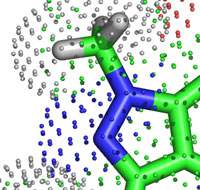
Sonochemical Reaction and Synthesis
Sonochemical Reaction and Synthesis
Sonochemistry is the application of ultrasound to chemical reactions and processes. The mechanism causing sonochemical effects in liquids is the phenomenon of acoustic cavitation.
Altrasonic ultrasonic laboratory and industrial devices are used in a wide range of sonochemical processes. Ultrasonic cavitation intensifies and speeds up chemical reactions such as synthesis and catalysis.

The intensity of acceleration is one of the most important factors influencing the efficient transformation of energy into cavitation. Higher acceleration creates higher pressure differences. This in turn increases the probability of the creation of vacuum bubbles instead of the creation of waves propagating through the liquid. Thus, the higher the acceleration the higher is the fraction of the energy that is transformed into cavitation. In case of an ultrasonic transducer, the intensity of acceleration is described by the amplitude of oscillation.
Higher amplitudes result in a more effective creation of cavitation. The industrial devices of Altrasonic Ultrasonics can create amplitudes of up to 115 µm. These high amplitudes allow for a high power transmission ratio what in turn allows to create high power densities of up to 100 W/cm³.
In addition to the intensity, the liquid should be accelerated in a way to create minimal losses in terms of turbulences, friction and wave generation. For this, the optimal way is a unilateral direction of movement.
Ultrasound is used because of its effects in processes, such as:
1. preparation of activated metals by reduction of metal salts
2. generation of activated metals by sonication
3. sonochemical synthesis of particles by precipitation of metal (Fe, Cr, Mn, Co) oxides, e.g. for use as catalysts
4. impregnation of metals or metal halides on supports
5. preparation of activated metal solutions
6. reactions involving metals via in situ generated organoelement species
7. reactions involving non-metallic solids
8. crystallization and precipitation of metals, alloys, zeolithes and other solids modification of surface morphology and particle size by high velocity interparticle collisions
1). formation of amorphous nanostructured materials, including high surface area transition metals, alloys, carbides, oxides and colloids
2). agglomeration of crystals
3). smoothing and removal of passivating oxide coating
4). micromanipulation (fractionation) of small particles
9. dispersion of solids
10. preparation of colloids (Ag, Au, Q-sized CdS)
11. intercalation of guest molecules into host inorganic layered solids
12. sonochemistry of polymers
1). degradation and modification of polymers
2). synthesis of polymers sonolysis of organic pollutants in water
© Copyright: 2025 Hangzhou Altrasonic Technology Co.,Ltd All Rights Reserved

IPv6 network supported
Scan to WhatsApp
